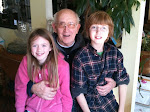WHEN CHILDREN TELL STORIES, by Mary Hamilton
When children tell stories, storytelling provides
practice attaching meaning to sound. The tellers receive practice in communicating through how they say words, not just through what words they choose to say.
experience with narrative form and conventions. Children gain practice with the interaction of characters, setting, conflict, and plot. They also gain practice in using chronological phrases -- ex. then, that night, one day, after that, meanwhile, the next day.
vicarious experience making decisions and living with the consequences. Story characters make decisions – some wise, some foolish, some in-between – then must live with the consequences however painful or unexpected they may be. As the aspiring teller works to learn the story, the teller imagines the decisions and consequences within the safe realm of the story, and then returns to our real world with insight into decisions and consequences.
actual experience with making decisions. The art of preparing a story for telling requires multiple decisions – Which story shall I tell? How do I believe this character talks, stands, walks, etc? What will my audience need to know to understand what happens in this story? How can I adapt this story for different ages of listeners? What can I do to help myself remember the events of the story?
increased sense of community. When the students tell stories, not only will student tellers sharing a program feel an increased sense of community, but also the tellers will be creating a community experience shared by all the listeners. Everyone listening will be able to refer to the story again and again.
increased communication skills. Yes, tellers gain experience talking in front of groups, but they also develop the skill of attending to listeners for nonverbal feedback to guide the teller in how to present the story. Using nonverbal feedback is an important skill for successful conversations and other everyday interactions as well as for successful public speaking.
exercise for the imagination. The tellers and their listeners will 1) create internal pictures of the places and people, and 2) experience emotions and empathize as they imagine story events through the eyes of various characters. The ability to imagine forms the foundation of all human planning, hoping, dreaming, and inventing.
Handout created by Mary Hamilton, www.maryhamilton.info
For permission to reuse, please contact Mary at 502-223-4523,
mary@maryhamilton.info or 65 Springhill Road, Frankfort, KY 40601-9211.
Bibliography
Here are resources you will find helpful as you engage your students in the art of storytelling.
Barton, Bob. Telling Stories Your Way: Storytelling and Reading Aloud in the Classroom. Markham, Ontario, Canada: Pembroke Publishers, 2000. Distributed in the US by Stenhouse Publishers. ISBN 1-55138-119-2
Collins, Rives and Pamela J. Cooper. The Power of Story: Teaching and Learning through Storytelling, 2nd edition. Scottsdale, Arizona: Gorsuch Scarisbrick, Publishers, 1997. ISBN 0-89787-362-9
Cooper, Patsy, When Stories Come to School: Telling, Writing & Performing Stories in the Early Childhood Classroom. New York: Teachers and Writers Collaborative, 1993. ISBN 0-915924-77-3
Gillard, Marni. Storyteller, Story Teacher: Discovering the Power of Storytelling for Teaching and Learning. York, Maine: Stenhouse Publishers, 1996. ISBN 1-57110-014-8
Hamilton, Martha and Mitch Weiss. Children Tell Stories: Teaching and Using Storytelling in the Classroom, 2nd edition. Katonoh, New York: Richard C. Owen Publishers, Inc. 2005. ISBN 1-57274-663-7 A DVD of children telling stories comes with this book.
Hamilton, Martha and Mitch Weiss. Stories in My Pocket: Tales Kids can Tell. Golden, Colorado: Fulcrum Publishing, 1996. ISBN 1-55591-957-X (pbk)
Norfolk, Sherry, Jane Stenson, and Diane Williams. The Storytelling Classroom: Applications Across the Curriculum. Westport,CT: Libraries Unlimited, 2006. ISBN 1-59158-305-5
Sima, Judy, and Kevin Cordi. Raising Voices: Creating Youth Storytelling Groups and Troupes. Westport, CT: Libraries Unlimited, 2003. ISBN 1-56308-919-X
WEBSITES
http://www.kystory.org Home of the Kentucky Storytelling Association. Learn about the Kentucky Youth Storytelling Competition, the Kentucky Storytelling Conference, and much, much more. On the Youth Storytelling opening page, you’ll find a link to participants telling at the National Youth Storytelling Showcase.
www.storyarts.org You’ll find lesson plans and other activities for engaging children with storytelling here, as well as lots of information for your own storytelling. Site by Heather Forest, a New York-based storyteller.
http://www.storybug.net You’ll find sections for teachers (including an overview of research on storytelling and learning and lots of curriculum tie-ins) and sections for kids. You’ll also find the absolute best set of links and pdf documents related to storytelling. Site by Karen Chace, Massachusetts-based storyteller and web researcher.
http://www.ncte.org/about/over/positions/category/curr/107637.htm This link will take you to the National Council of Teachers of English Position Statement on Storytelling.
Handout created by Mary Hamilton, www.maryhamilton.info
For permission to reuse, please contact Mary at 502-223-4523,
mary@maryhamilton.info or 65 Springhill Road, Frankfort, KY 40601-9211.


0 Comments:
Post a Comment
<< Home